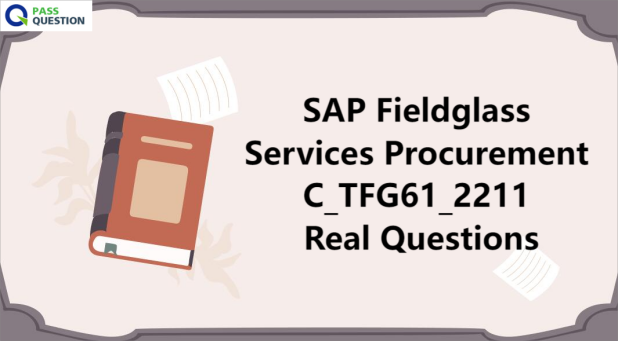SAP Fieldglass Services Procurement C_TFG61_2211 Real Questions
To ensure that you are fully equipped for success in the C_TFG61_2211 SAP Application Associate - SAP Fieldglass Services Procurement exam, it is important to have a comprehensive preparation plan. One highly recommended approach is to utilize the latest SAP Fieldglass Services Procurement C_TFG61_2211 Real Questions from PassQuestion. These real questions are specifically designed to simulate the actual exam environment, allowing you to familiarize yourself with the types of questions you may encounter. By practicing with these SAP Fieldglass Services Procurement C_TFG61_2211 Real Questions, you can gain valuable insights into the exam format and identify any areas where you may need further study.

C_TFG61_2211 Exam Description - SAP Application Associate - SAP Fieldglass Services Procurement
The "SAP Application Associate - SAP Fieldglass Services Procurement" certification exam verifies that the candidate has the fundamental knowledge of configuration, administration, analytics and integration required for services procurement. This certificate proves that the candidate has an overall understanding on the services procurement workflow and can implement the knowledge practically in projects to contribute to the success in a mentored role.
Exam Information
Exam Code: C_TFG61_2211
Exam Name: SAP Certified Application Associate - SAP Fieldglass Services Procurement
Level: Associate
Exam: 60 questions
Cut Score: 65%
Duration: 120 mins
Languages: English
Topic Areas
Company Structure and Financial Data > 12%
Rate structures > 12%
Contingent Transactions > 12%
Configuration, System tools and Messaging > 12%
Users 8% - 12%
Supplier and Workflow 8% - 12%
Analytics and Integrations 8% - 12%
View Online SAP Fieldglass Services Procurement C_TFG61_2211 Free Questions
1. What functionality is used to organize SOW templates and suppliers?
A.Categories
B.Qualifications
C.Questions
D.Classifications
Answer: D
2. Why would you associate proxy roles to a user role?
A.To select proxies for a single user that could serve as a proxy
B.To select proxies for multiple user roles that could serve as proxies for all
C.To select a single user who can perform the role of a proxy
D.To select the roles that could serve as proxies for that role
Answer: D
3. Which of the following describes the difference between a general ledger and a general ledger account?
A.They are both related functionalities used for the same purpose.
B.A general ledger account is associated with task and expense codes rather than a business unit
C.General ledgers are required, while general ledger accounts are optional.
D.A general ledger account is associated with a business unit rather than task and expense codes.
Answer: B
4. Which of the following are aspects of the Data Dictionary functionality? Note: There are 2 correct answers to this question.
A.It is split into two groups; report fields and formulas
B.It is located in every user's Reference Library.
C.It is where users can see all reportable fields in the application
D.It is accessed via the Admin menu under the Report header.
Answer: C, D
5. The Messaging section within the SAP Fieldglass admin menu allows Administrator users to perform which of the following activities? Note: There are 2 correct answers to this question.
A.Create reminders for various user groups within SAP Fieldglass
B.Manage the various aspects of notifications generated from within SAP Fieldglass.
C.Chat with buyer users and supplier users regarding current transactions
D.Send direct messages to users of SAP Fieldglass.
Answer: A, B
6. Which of the following are examples of an activity checklist? Note: There are 3 correct answers to this question.
A.Reset username and password details
B.Worker and supplier evaluation
C.Worker and supplier onboarding and offboarding
D.New SAP Fieldglass account registration
E.Contract negotiation and authorization
Answer: B, C, E
7. What is the next step after creating a rate?
A.Create Rate Group
B.Create Rate Grid
C.Create Rate Category
D.Create Worker Pay Type
Answer: A
8. What SOW workflow would provide them with the highest volume of control?
A. Worker-defined
B. Supplier-defined
C. Buyer-defined
D. Buyer and Supplier defined
Answer: C
9. Which of the following applies to tracking Workers on an SOW?
A. SOW Workers are required for time and expense purposes.
B. Only buyer companies that use the contingent workflow can add Workers to their SOW.
C. Only buyer companies that use the SOW Bid functionality can add Workers to their SOWS.
D. SOW Workers are optional when buyers utilize SOWS.
Answer: A
10. Where on the Worker record are Asset Types assigned?
A. Cost Allocation tab
B. Related tab
C. Details tab
D. Manage tab
Answer: B
- TOP 50 Exam Questions
-
Exam
All copyrights reserved 2025 PassQuestion NETWORK CO.,LIMITED. All Rights Reserved.

